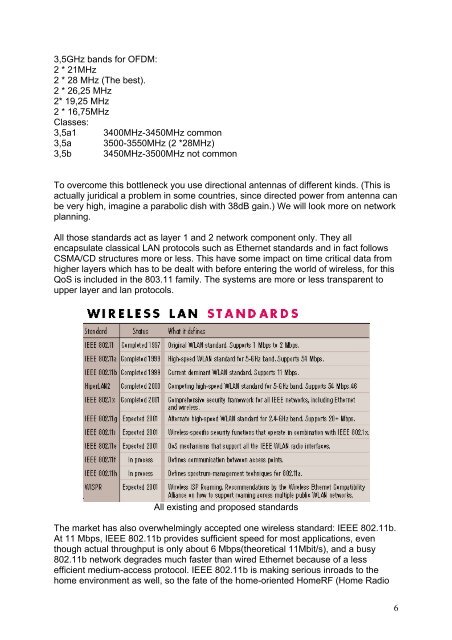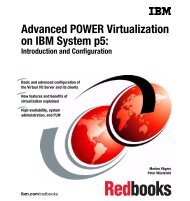Wireless LAN
Wireless LAN
Wireless LAN
You also want an ePaper? Increase the reach of your titles
YUMPU automatically turns print PDFs into web optimized ePapers that Google loves.
3,5GHz bands for OFDM:<br />
2 * 21MHz<br />
2 * 28 MHz (The best).<br />
2 * 26,25 MHz<br />
2* 19,25 MHz<br />
2 * 16,75MHz<br />
Classes:<br />
3,5a1 3400MHz-3450MHz common<br />
3,5a 3500-3550MHz (2 *28MHz)<br />
3,5b 3450MHz-3500MHz not common<br />
To overcome this bottleneck you use directional antennas of different kinds. (This is<br />
actually juridical a problem in some countries, since directed power from antenna can<br />
be very high, imagine a parabolic dish with 38dB gain.) We will look more on network<br />
planning.<br />
All those standards act as layer 1 and 2 network component only. They all<br />
encapsulate classical <strong>LAN</strong> protocols such as Ethernet standards and in fact follows<br />
CSMA/CD structures more or less. This have some impact on time critical data from<br />
higher layers which has to be dealt with before entering the world of wireless, for this<br />
QoS is included in the 803.11 family. The systems are more or less transparent to<br />
upper layer and lan protocols.<br />
All existing and proposed standards<br />
The market has also overwhelmingly accepted one wireless standard: IEEE 802.11b.<br />
At 11 Mbps, IEEE 802.11b provides sufficient speed for most applications, even<br />
though actual throughput is only about 6 Mbps(theoretical 11Mbit/s), and a busy<br />
802.11b network degrades much faster than wired Ethernet because of a less<br />
efficient medium-access protocol. IEEE 802.11b is making serious inroads to the<br />
home environment as well, so the fate of the home-oriented HomeRF (Home Radio<br />
6
















